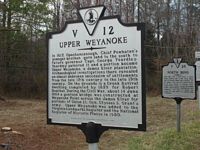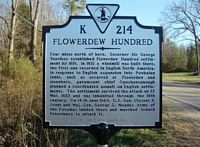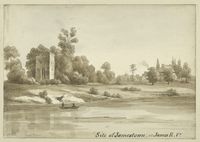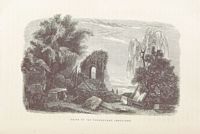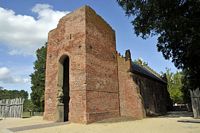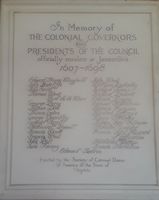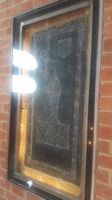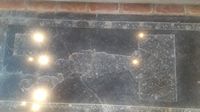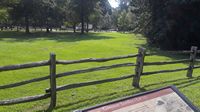1587 - Southwark, Surrey, England
10 NOV 1627 - Jamestown, VA
George Yeardley
George Yeardley >> Argoll Yeardley >> Argoll Yeardley >> Sarah Yeardley >> Sarah Powell >> Elizabeth Haggoman >> Elizabeth Jacob >> Arthur Barnes >> James Barnes >> Susan Barnes >> Eddie Barnes >> Thelma Barnes >> Frances Franklin >> Mark DameronImmigrant and three time Governor of Virginia. Presided over first representative government in America and was one of the first slaveholders in the New World.
 George Yeardley was born in 1587 in Southwark, Surrey, England just across the Thames River from London. His father, Ralph Yeardley was a tailor and his mother was Rhoda Marston. George had at least one sibling, a brother named Ralph. Around 1605 George accompanied Sir Thomas Gates to the Netherlands and served in a company of foot-soldiers under Gates during the Netherlands war with Spain. Gates was hired by the Virginia Company of London in 1609 to lead a fleet of nine ships and 600 passengers to resupply the struggling settlement at Jamestown - George Yeardley joined him for the adventure. They set sail on June 2nd, 1609.
George Yeardley was born in 1587 in Southwark, Surrey, England just across the Thames River from London. His father, Ralph Yeardley was a tailor and his mother was Rhoda Marston. George had at least one sibling, a brother named Ralph. Around 1605 George accompanied Sir Thomas Gates to the Netherlands and served in a company of foot-soldiers under Gates during the Netherlands war with Spain. Gates was hired by the Virginia Company of London in 1609 to lead a fleet of nine ships and 600 passengers to resupply the struggling settlement at Jamestown - George Yeardley joined him for the adventure. They set sail on June 2nd, 1609.
The fleet sailed into a hurricane on July 24th, 1609. The lead ship, called "Sea Venture," carrying both Yeardley and Gates was run aground in Bermuda while two other ships were wrecked. The passengers and crew over-wintered in Bermuda while they built two new boats from the remains of "Sea Venture" and the local Bermuda cedar. "Patience" and "Deliverance" sailed into Jamestown, VA on May 24th, 1610. They arrived to find the colony still in dire straits despite the six ships that had arrived the previous year. Gates served as Deputy Governor for two months until the return of Thomas West and installed martial law in the settlement. Gates named George Yeardley as captain of the guard and in 1611 he was promoted to a lieutenant. In 1613 Sir Thomas Dale founded the Bermuda Hundred Plantation and hired George as his second in command. Dale served as acting governor during another absence by Thomas West but left the colony on April 19th, 1616 to escort John Rolfe and Pocahontas to London. George Yeardley was named Deputy Governor until the arrival of Samuel Argall on May 15th, 1617.
George returned to England later in 1617. He married Temperance Flowerdew on October 18th, 1618. Temperance had been in the colony and had sailed with the same fleet as George, but her ship, "Falcon," had arrived safely. Exactly one month later The Virginia Company appointed George to serve as Governor of Virginia and gave him a set of instructions that came to be known as The Great Charter. The document established the head right system, and ended the military government by using a royally appointed governor and council while allowing the governor to call a general assembly to create legislation. On November 24th George was knighted by King James I during an audience at Newmarket in Surrey, England to boost his social standing with the colonists upon his return to Jamestown.
George and Temperance sailed for Virginia on January 19th, 1619 and arrived on April 18th. George assumed the role of Governor and began implementing The Great Charter. He put out a call for each of the colony's 11 settlements to elect two burgesses to send to Jamestown. George established the Flowerdew Hundred Plantation on 1,000 acres on the south side of the James River. Either the land was named for his wife, or it was already in use by the Flowerdew family before being patented.
On July 30th, 1619 the General Assembly held its first session in the church at Jamestown. George presided over the unicameral body that included; the Burgesses, the Governor's Council, the secretary of the colony and the treasurer. The body voted to set the price of tobacco among other things. This meeting was the first form of representative government to meet in America. The following month a ship called "The White Lion," captained by John Colyn Jope arrived at Point Comfort. That ship and another called "The Treasurer" sold the first African slaves in the Colony. George Yeardley appears to have been among the buyers. A 2018 Washington Post article noted the significance of George Yeardley's summer of 1619:
"Thus, he represents two of the chief veins in American history — representative government and slavery, which took root in the same summer, in the same place, in the person of the same man."
The slaves first brought to Jamestown were stolen cargo from a Portuguese ship bound for Mexico. The piracy was viewed unfavorably by the crown at a time when the King was trying to improve relations with Spain. It also turned out that the "The Treasurer" was partly owned by one of the wealthy investors in the Virginia Company, Samuel Argall, the man who proceeded George as governor and who George had named his first son after. Many in the colony that favored the military style of government over provisions of The Great Charter used the incident to raise their concerns about George Yeardley, among the critics was Sir Thomas Gates, Yeardley's old commander. George agreed to resign as governor as soon as a replacement could be sent and he accepted a position on the Governor's Council.
In 1620 George travelled to the Eastern Shore. There he and Thomas Savage both received large tracts of land from Debedeavon "The Laughing King," leader of the Accomack tribe. Debedeavon was interested in having a peaceful releationship with the new white settlers, he even warned the colonial government about the attacks Powhatan was planning to carry out in 1622. The land George received stretched from Hungars Creek on the bayside, all the way across the shore and measured 3,700 acres. Eventually the state government issued a patent to George for the property. After his death the land passed to Argoll Yeardley, who had a patent for 3,700 acres reissued in 1638.
In 1621 George paid 120 pounds to have a windmill built at Flowerdew Hundred, the first in North America.
On March 22nd, 1622 the attacks on white settlements by Powhatan, warned of by Debedeavon, took place up and down the James River and killed as many as a third of the colonists living in Virginia. Flowerdew Hundred saw six people killed. George led marches to counter-attack throughout the following year.
In a muster of the Colony in February 1624 George and family were recorded living in Jamestown along with eight white servants and two Black slaves. Around that time George sold Flowerdew Hundred and patented 100 acres, including 7.5 acres in Jamestown City. Also in 1624 the governor of Virginia, Francis Wyatt, traveled to London and George was appointed to serve as interim. Due to the struggling finances of the Virginia Company and the effects of the 1622 Massacre the crown decided to dissolve the company. Even with the colony struggling, George appeared to do quite well. In January of the following year George listed 39 laborers, eight of whom were Black slaves. After the dissolution of the Virginia Company James and Temperance traveled to London in the summer and fall of 1625 and George delivered a letter to the Privy Council on the conditions in Virginia.
The following spring George was again appointed by the King of England to be Governor of Virginia. George and his family departed England on April 19th, 1626 to sail back to Jamestown. In January of 1627 George received 18 indentured servants who had previously belonged to the Virginia Company and still had seven years of service remaining on their 14 year indentures. Later in 1627 George founded another 1,000 acre plantation on Mulbery Island, 10 miles down river from Jamestown on the north side of the James. He named the new plantation Stanley Hundred in honor of Temperance's mother, Martha Stanley.
George did not complete his third term as governor. He took ill and wrote a will on October 12th, 1627. He ordered his land except the Stanley Plantation and land at Jamestown should go to Argoll and the other property be sold and added to the value of his estate and then the estate to be divided into three equal parts with one part going to Temperance, another part to their son Argoll and the final part to be divided between Elizabeth and Francis. George Yeardley died at Jamestown on November 10th, 1627 and was buried inside the church three days later.
Temperance stayed in Jamestown and married the new governor, Francis West, in March of 1628. She soon took ill as well and died intestate at Jamestown in December of 1628. The three children were sent back to London and raised by George's brother, Ralph Yeardley. Argoll and Francis both returned to the colony, but only Argoll had children. Nothing more is known about Elizabeth.
In the summer of 2018 archaeologists at Jamestown announced that they were excavating a grave at Jamestown Church that they believe to be George Yeardley. The grave dates from the same time as George's death and was covered with the emblem of a knight. Only two knights were known to have died in Jamestown at that time and forensic analysis of the remains showed a diet rich in corn for many years. The other knight had only been in Jamestown a couple of years and would not have consumed as much corn. The location of the grave indicated that it was for a prominent citizen. The body was believed to have laid in-state because of the positioning of the remains and the way in which the body was wrapped. Analysis of the skeleton showed abnormalities in the leg and collar bones that indicated some type of long-term chronic disease. Also notable about the skeleton was a broken nose that had been healed before death and a height of about 5'6" which was reasonably tall for the time. Genetic testing is currently being performed on the body.
Documents:

- The Great Charter, 1618 (PDF)
- Artists Rendering of the 1622 Massacre
- 1625 Account of the sinking of the Sea Venture - 2 - 3
- 1626 Commission as Governor (PDF)
- 1627 Will - 2 - 3
- 1627 Will Transcript - 2 - 3
- 1915 Encyclopedia of Virginia Biography - 2 - 3
- Yeardley Genealogy (PDF)
- Descendants of George Yeardley (PDF)
- The Father of Representative Government in America (PDF)
Map:

Comments:

Sources:

- Dorman, John F. Adventurers of Purse and Person : Virginia 1607-1624/5: Volume Three Families R-Z. Baltimore, MD: Genealogical Pub. Co, 2007. Print. Pg. 861.
- Ancestry.com. England & Wales, Prerogative Court of Canterbury Wills, 1384-1858 [database on-line]. Provo, UT, USA: Ancestry.com Operations, Inc., 2013. Original data: Prerogative Court of Canterbury: Wills of Selected Famous Persons. Digitized images. Records of the Prerogative Court of Canterbury, Series PROB 1. The National Archives, Kew, England.Prerogative Court of Canterbury and Related Probate Jurisdictions: Will Registers. Digitized images. Records of the Prerogative Court of Canterbury, Series PROB 11. The National Archives, Kew, England.
- Miles Files, Eastern Shore Public Library, http://espl-genealogy.org
- Wikipedia, https://en.wikipedia.org/wiki/George_Yeardley
- Wolfe, Brendan. "Sir George Yeardley (bap. 1588–1627)." Encyclopedia Virginia. Virginia Foundation for the Humanities, 24 Jul. 2018. Web. 28 Oct. 2018.
- William Strachey, A true reportory of the wracke, and redemption of Sir Thomas Gates Knight, in Hakluytus posthumus, or, Purchas his Pilgrimes, compiled by Samuel Purchas (London: H. Fetherston, 1625) 4:1735, Library of Congress
- The Thomas Jefferson Papers Series 8. Virginia Records Manuscripts. 1606– 1737. Susan Myra Kingsbury, ed., Records of the Virginia Company, 1606–1626, 3:241–242, 243–245, 247–248.
- Ruane, Michael E. “Archaeologists Have Found the Remains of One of Jamestown’s Early Settlers. Now They Have to Prove He Is Who They Think He Is.” The Washington Post, 24 June 2018
- UPSHUR, THOMAS TEACKLE. “SIR GEORGE YEARDLEY OR YARDLEY, GOVERNOR AND CAPTAIN-GENERAL OF VIRGINIA, AND TEMPERANCE, LADY YEARDLEY, AND SOME OF THEIR DESCENDANTS.” The American Historical Magazine, vol. 1, no. 4, 1896, pp. 339–374. JSTOR, JSTOR, www.jstor.org/stable/42657115.
- Garrett, W. R. “THE FATHER OF REPRESENTATIVE GOVERNMENT IN AMERICA.” The American Historical Magazine, vol. 1, no. 1, 1896, pp. 3–21. JSTOR, JSTOR, www.jstor.org/stable/43700484.
- “GENEALOGICAL NOTES.” The American Historical Magazine, vol. 1, no. 1, 1896, pp. 92–102. JSTOR, JSTOR, www.jstor.org/stable/43700489
- Nugent, Nell Marion. Cavaliers And Pioneers: Abstracts of Virginia Land Patents And Grants, 1623-1800. [1st ed.]. Richmond: Press of the Dietz Print Co., 19341999.
- The Thomas Jefferson Papers Series 8. Virginia Records Manuscripts. 1606–1737. Susan Myra Kingsbury, ed., Records of the Virginia Company, 1606–1626, 3:98–109.
- “Commission to Governor Yeardley and Council, March 14, 1625-6.” The Virginia Magazine of History and Biography, vol. 13, no. 3, 1906, pp. 298–302. JSTOR, JSTOR, www.jstor.org/stable/4242747.
- Tyler, Lyon Gardiner, 1853-1935. Encyclopedia of Virginia Biography. New York: Lewis historical publishing company, 1915.
- Turman, Nora M. The Eastern Shore of Virginia, 1603-1964. Onancock, Va: Eastern Shore News, 1964. Print. Pgs. 8, 16.
- Wright, F E. Northampton County, Virginia: Marriage References and Family Relationships 1634-1800. Lewes, Del: Colonial Roots, 2012. Print. Pg. 233.
- Whitelaw Ralph T. Virginia's Eastern Shore; a History of Northampton and Accomack Counties. P. Smith 19681951.
Future 2:

Future 3:

Future 4:

Future 3:

Parents:
- Ralph Yeardley
1560-1601
- Rhoda Marston
1560-1601
1560-1601
1560-1601
Spouse & Children:
- Temperance Flowerdew
1590-1628
- Elizabeth Yeardley
1619-
- Argoll Yeardley, Sr.
1621-1655
- Francis Yeardley
1623-
- Temperance Flowerdew
1590-1628
- Elizabeth Yeardley
1619-
- Argoll Yeardley, Sr.
1621-1655
- Francis Yeardley
1623-
Siblings:
- Ralph Yeardley
1585-
1585-

